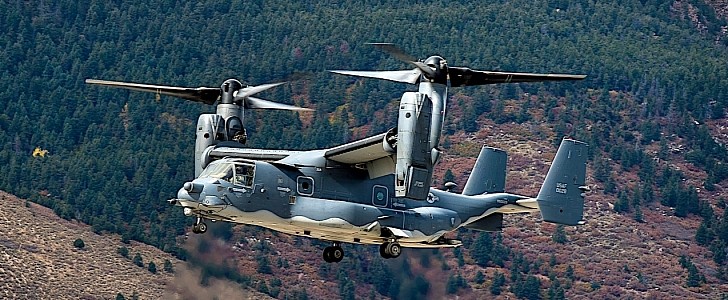Despite the design making them some incredibly nimble machines, tiltrotor aircraft are as rare as hens’ teeth. In fact, there’s only one successful such machine out there, regularly conducting military business: the V-22 Osprey.
Introduced by Bell and Boeing in 2007, after a couple of decades of testing, the Osprey can now be seen in the skies of the world in several variants, from the CV-22 deployed by the U.S. Air Force to the Marine Corps MV-22 and U.S. Navy’s CMV-22. They’re all pretty much the same, of course, with adaptations to suit the needs of the various military branches.
Generally speaking, the bird is powered by a pair of Rolls-Royce Liberty engines, that develop 6,200 shaft horsepower each. The combo allows the machine to reach a top speed of 322 mph (518 kph) and altitudes of up to 25,000 feet (7,620 meters).
The Osprey has been designed to operate both as an airplane and a helicopter, meaning it can take off and land either horizontally (on short runways) or vertically. This greatly expands the aircraft’s reach and makes it suitable for a larger range of missions.
The one we have here is on a behold-and-be-amazed mission, if we can call it that. Deployed with the 58th Special Operations Wing, the helicopter was on a mission to the Air Force Academy in Colorado Springs, Colorado.
There, the Osprey had to conduct what the Air Force calls a mountain landing, then provide the cadets there with “familiarization opportunities and orientation flights in an effort to develop knowledge and passion for airpower within the cadet wing.”
We’re pretty certain tons of civilians would love to take a ride in this thing as well but, as is, the Osprey is for now restricted to the military. That may change soon, as last year the Italians from Leonardo announced the AW609, a bird we’ll talk about at length this coming weekend.
Generally speaking, the bird is powered by a pair of Rolls-Royce Liberty engines, that develop 6,200 shaft horsepower each. The combo allows the machine to reach a top speed of 322 mph (518 kph) and altitudes of up to 25,000 feet (7,620 meters).
The Osprey has been designed to operate both as an airplane and a helicopter, meaning it can take off and land either horizontally (on short runways) or vertically. This greatly expands the aircraft’s reach and makes it suitable for a larger range of missions.
The one we have here is on a behold-and-be-amazed mission, if we can call it that. Deployed with the 58th Special Operations Wing, the helicopter was on a mission to the Air Force Academy in Colorado Springs, Colorado.
There, the Osprey had to conduct what the Air Force calls a mountain landing, then provide the cadets there with “familiarization opportunities and orientation flights in an effort to develop knowledge and passion for airpower within the cadet wing.”
We’re pretty certain tons of civilians would love to take a ride in this thing as well but, as is, the Osprey is for now restricted to the military. That may change soon, as last year the Italians from Leonardo announced the AW609, a bird we’ll talk about at length this coming weekend.









